Impact of Nonlinear Lighting Loads on the Neutral Conductor Current of Low Voltage Residential Grids
Abstract
1. Introduction
2. Simulation Framework
2.1. LV Network
- Feeder (i). A 280 m 3P4W branch, with single 3P4W branches of 20 m, located every 40 m.
- Feeder (ii). A 240 m 3P4W branch, with double 3P4W branches of 40 m, located every 40 m.
- Feeder (iii). An 80 m 3P4W branch, with three 1P2W branches of 60 m located at the end of the three-phase branch.
2.2. Lamps
2.3. Simulation Scenarios
2.4. Implementation
2.4.1. Monte Carlo Simulation
2.4.2. Neutral Conductor Current Calculation
2.4.3. Neutral Conductor Current Assessment
3. Simulation Results
3.1. Impact of the Lighting Technology
3.2. Impact of Supply Voltage Distortion
3.3. Impact of Load Unbalance
4. Discussion of Results
5. Conclusions
Author Contributions
Funding
Acknowledgments
Conflicts of Interest
Nomenclature
| IHL | Incandescent and Halogen Lamps |
| CFL | Compact Fluorescent Lamps |
| LED | Light Emitting Diode |
| RMS | Root Mean Square |
| n | Number of Monte Carlo iterations |
| ε | Percent error |
| s | Sample standard deviation |
| Sample mean | |
| Quantile of the normal distribution | |
| h | Harmonic order |
| N | Number of installed lamps |
| k | Lamp number |
| z | Analysis point |
| p | Network’s phase |
| Individual harmonic currents | |
| Harmonic components of the neutral conductor current | |
| In,h,z | RMS value of individual harmonic components of the neutral conductor current |
| In,rms,z | Total RMS neutral conductor current |
| PR | Prevailing Ratio |
| CUF | Negative sequence unbalance factor of line currents |
| Pearson coefficient |
Appendix A
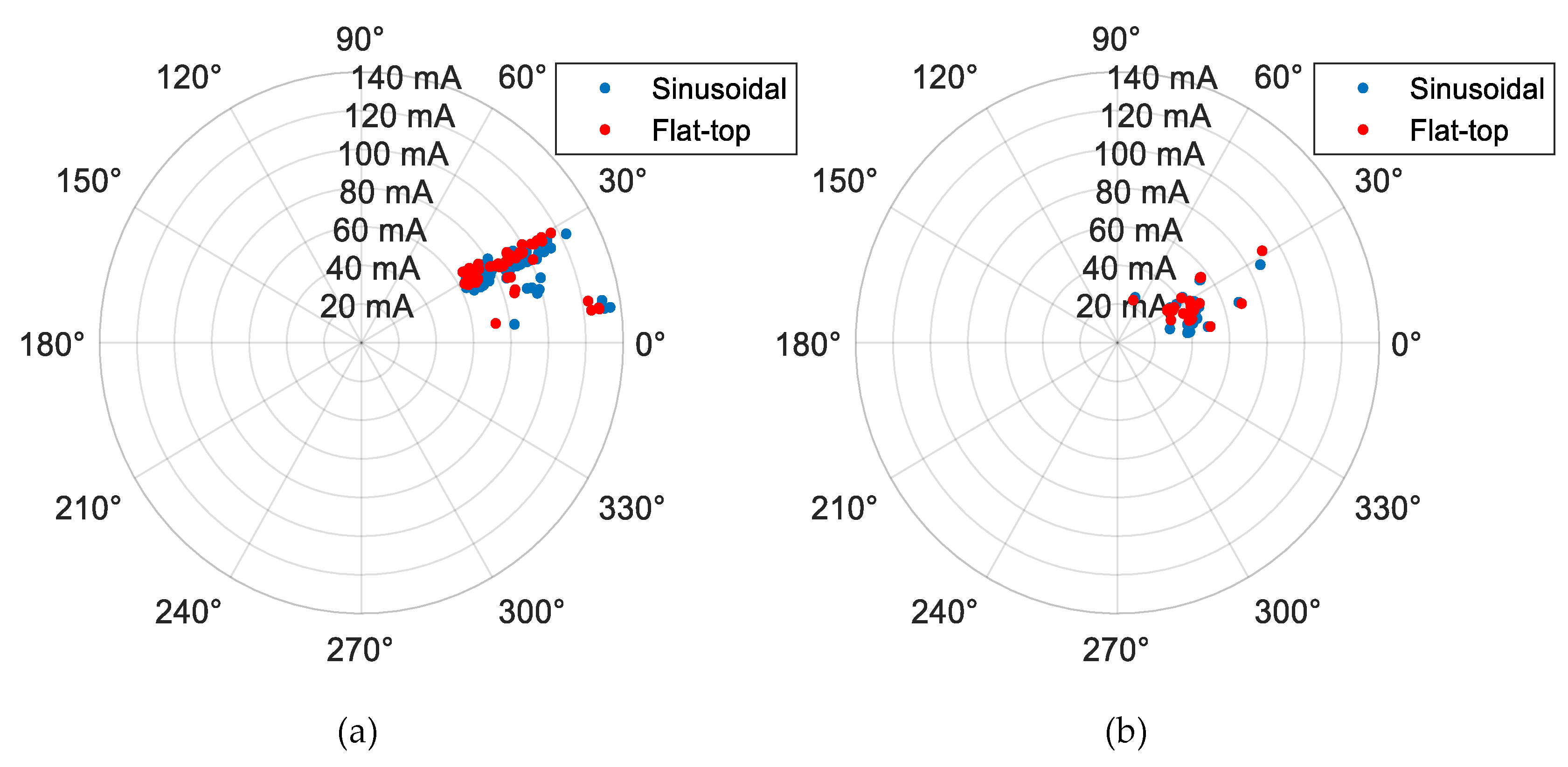
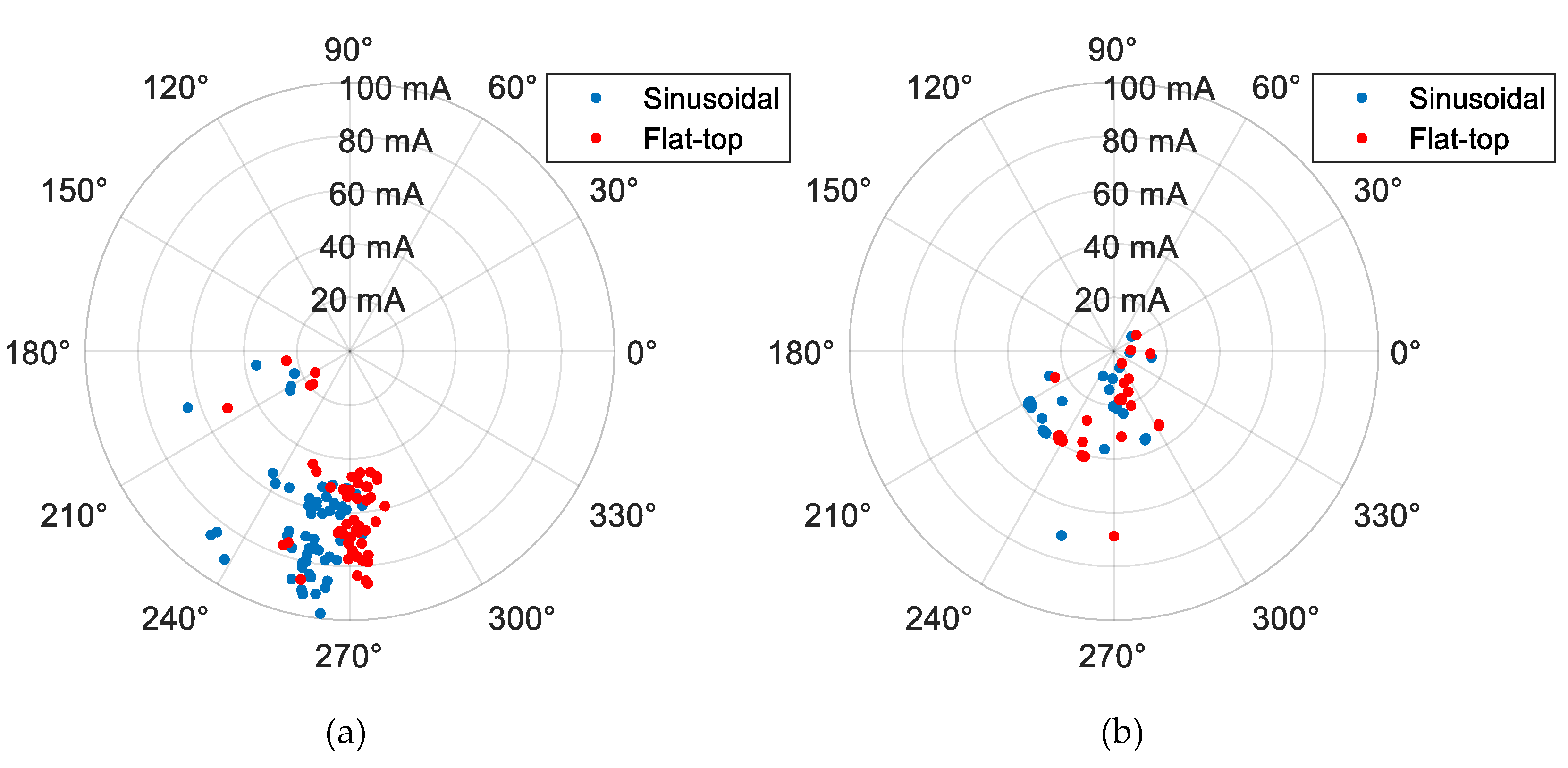
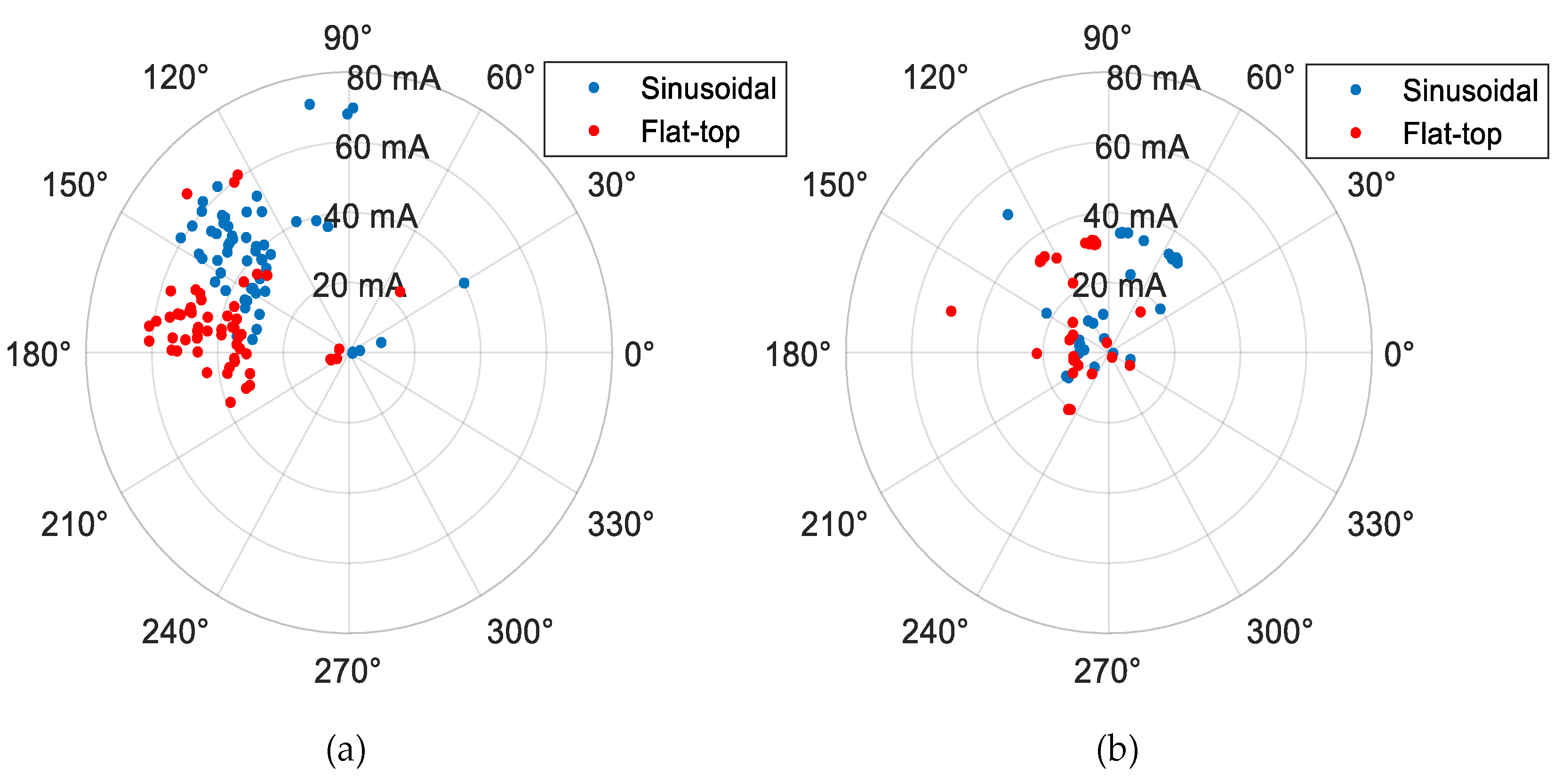
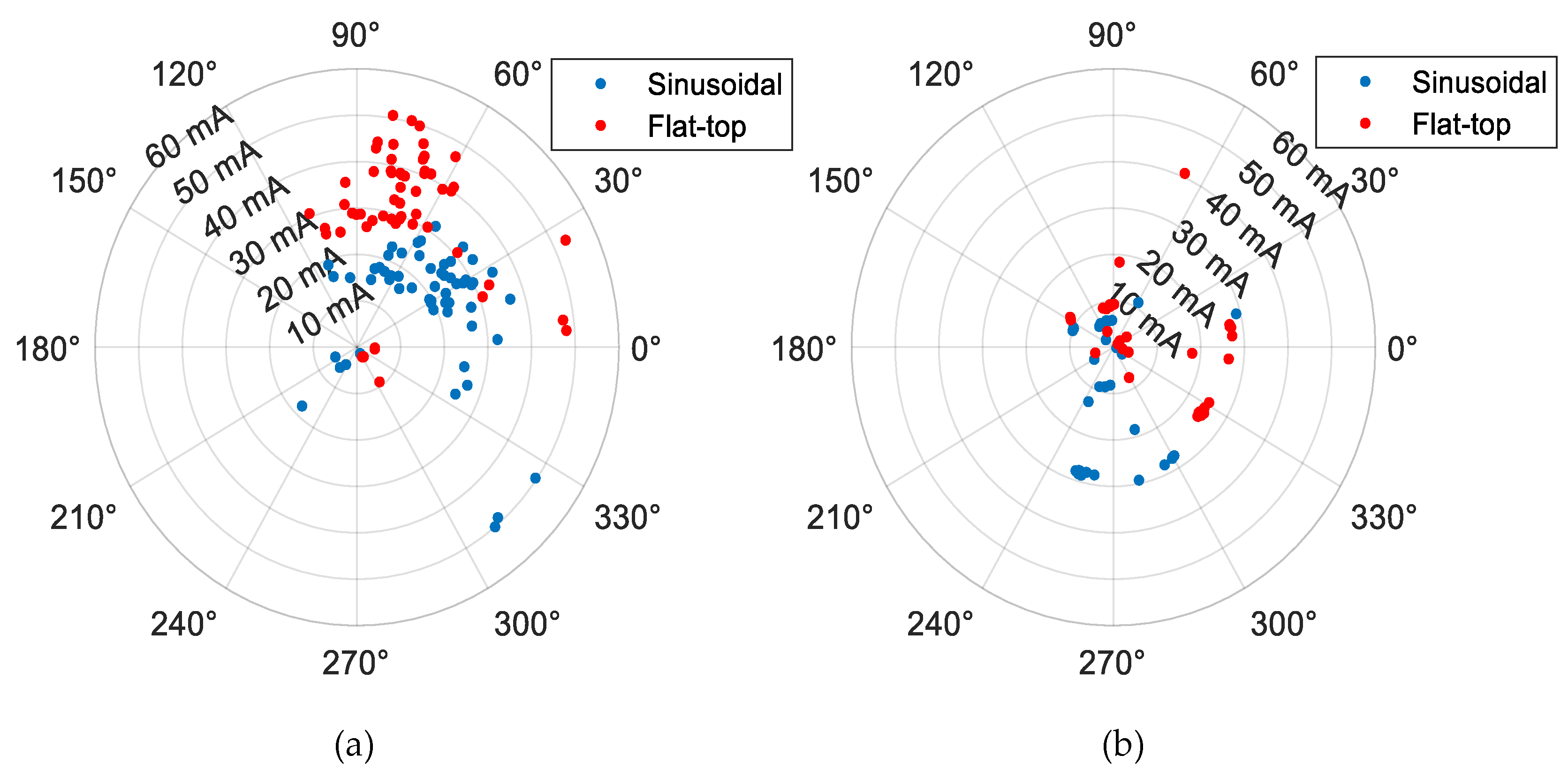
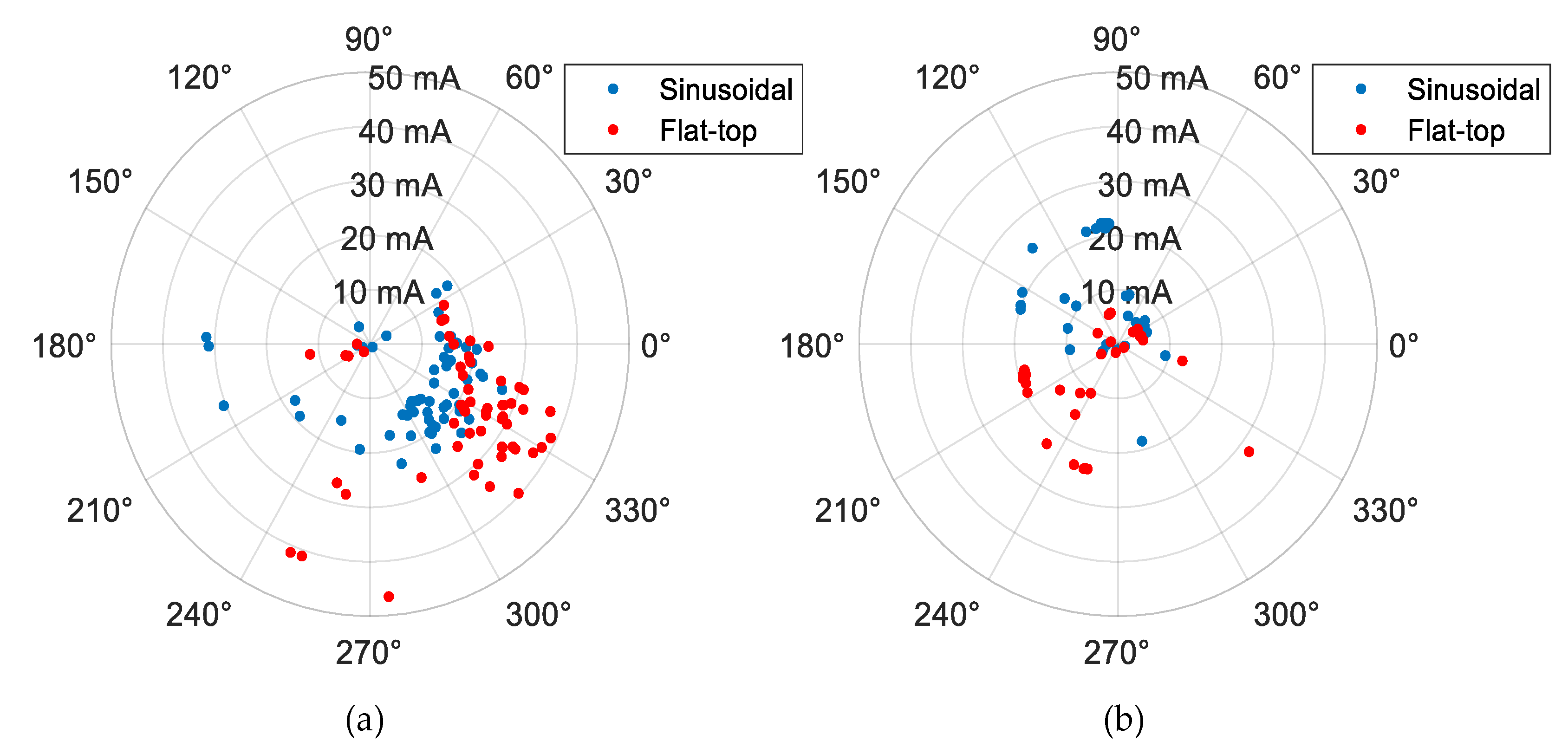
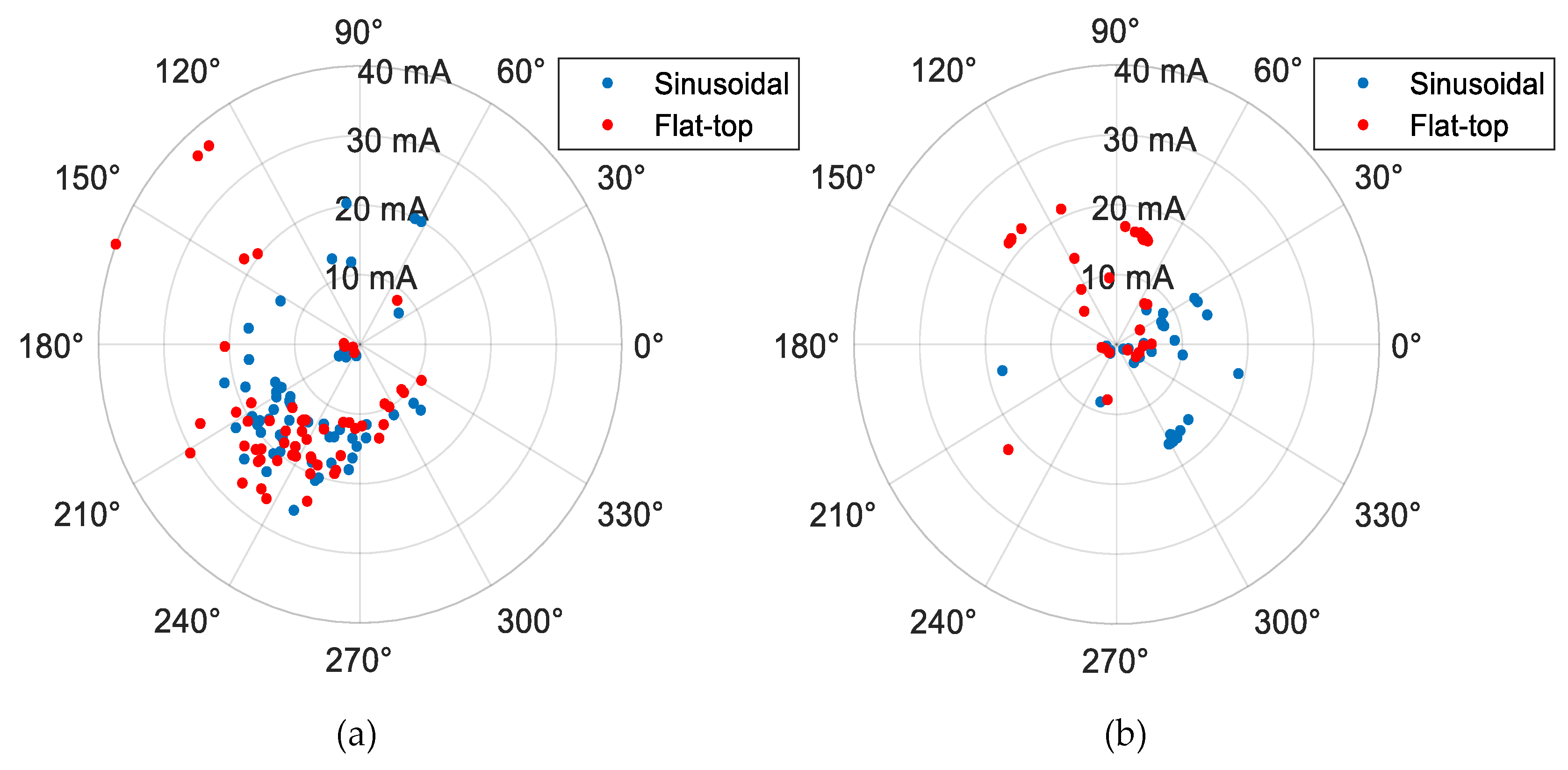

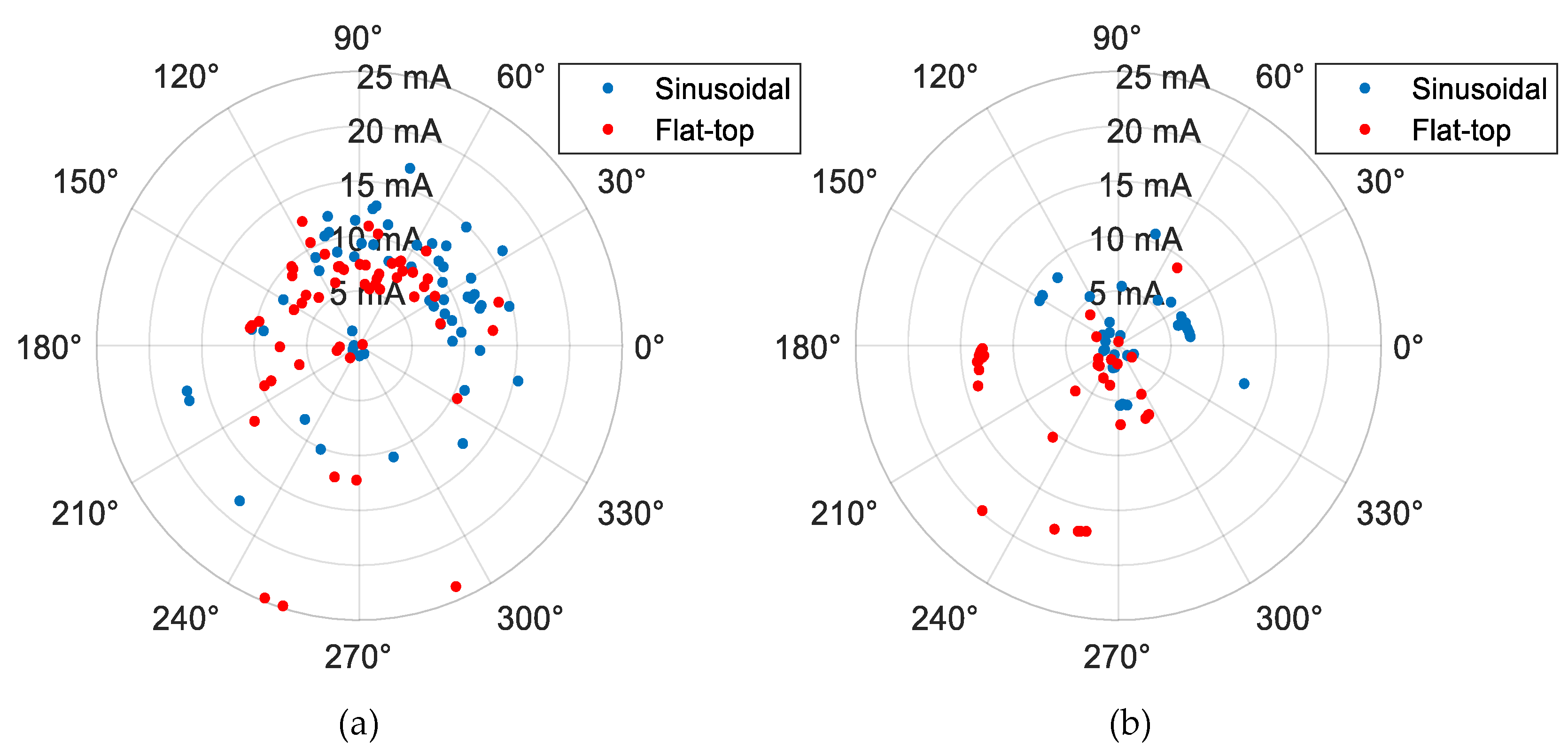
References
- Abergel, T. “International Energy Agency—Lighting Report.”. 2020. Available online: https://www.iea.org/reports/lighting (accessed on 19 July 2020).
- Blanco, A.M.; Stiegler, R.; Meyer, J.; Meyer, J. Power quality disturbances caused by modern lighting equipment (CFL and LED). In Proceedings of the 2013 IEEE Grenoble Conference, Grenoble, France, 16–20 June 2013; Institute of Electrical and Electronics Engineers (IEEE): Piscataway, NJ, USA, 2013; pp. 1–6. [Google Scholar]
- Ronnberg, S.K.; Bollen, M. Power quality issues in the electric power system of the future. Electr. J. 2016, 29, 49–61. [Google Scholar] [CrossRef]
- Xu, X.; Gunda, J.; Fang, D. Modelling and Aggregation of LED Lamps for Network Harmonic Analysis. In Proceedings of the 2018 Power Systems Computation Conference (PSCC), Dublin, Ireland, 11–15 June 2018; Institute of Electrical and Electronics Engineers (IEEE): Piscataway, NJ, USA, 2018; pp. 1–7. [Google Scholar]
- Molina, J.; Mesas, J.J.; Mesbahi, N.; Sainz, L. LED lamp modelling for harmonic studies in distribution systems. IET Gener. Transm. Distrib. 2017, 11, 1063–1071. [Google Scholar] [CrossRef]
- Collin, A.J.; Drapela, J.; Langella, R.; Testa, A.; Djokic, S.Z.; Watson, N.R. Harmonic Modelling of LED lamps by Means of Admittance Frequency Coupling Matrices. In Proceedings of the 2019 IEEE Milan PowerTech, Milan, Italy, 23–27 June 2019; pp. 1–6. [Google Scholar] [CrossRef]
- Martinez-Penaloza, A.; Carrillo-Sandoval, L.; Osma-Pinto, G. Determination and Performance Analysis of the Norton Equivalent Models for Fluorescents and LED Recessed Lightings. In Proceedings of the 2019 IEEE Workshop on Power Electronics and Power Quality Applications (PEPQA), Manizales, Colombia, 30–31 May 2019; Institute of Electrical and Electronics Engineers (IEEE): Piscataway, NJ, USA, 2019; pp. 1–6. [Google Scholar]
- Liew, A.-C. Excessive neutral currents in three-phase fluorescent lighting circuits. IEEE Trans. Ind. Appl. 1989, 25, 776–782. [Google Scholar] [CrossRef]
- Cunill-Solà, J.; Sainz, L.; Mesas, J.J. Neutral conductor current in three-phase networks with compact fluorescent lamps. Electr. Power Syst. Res. 2013, 103, 70–77. [Google Scholar] [CrossRef]
- Phannil, N.; Jettanasen, C.; Ngaopitakkul, A. Harmonics and Reduction of Energy Consumption in Lighting Systems by Using LED Lamps. Energies 2018, 11, 3169. [Google Scholar] [CrossRef]
- Jarkovoi, M.; Iqbal, M.N.; Kutt, L. Analysis of Harmonic Current Stability and Summation of LED Lamps. In Proceedings of the 2019 Electric Power Quality and Supply Reliability Conference (PQ) & 2019 Symposium on Electrical Engineering and Mechatronics (SEEM), Kärdla, Estonia, 12–15 June 2019; Institute of Electrical and Electronics Engineers (IEEE): Piscataway, NJ, USA, 2019; pp. 1–8. [Google Scholar]
- Shabbir, H.; Rehman, M.U.; Rehman, S.A.; Sheikh, S.K.; Zaffar, N. Assessment of harmonic pollution by LED lamps in power systems. In Proceedings of the 2014 Clemson University Power Systems Conference, Clemson, SC, USA, 11–14 March 2014; Institute of Electrical and Electronics Engineers (IEEE): Piscataway, NJ, USA, 2014; pp. 1–7. [Google Scholar]
- Veloso, P.; Gonçalves, B.; Morgado, S.; Bastião, F.; Tavares, R. LED Technology in Public Lighting—Analysis of the Impact in Power Quality in the Low Voltage Grid Distribution. In Proceedings of the 25th International Conference on Electricity Distribution, Madrid, Spain, 3–6 June 2019; AIM: Sydney, Austalia, 2019. [Google Scholar]
- Hermoso-Orzáez, M.J.; Rojas-Sola, J.; Gago-Calderón, A. Electrical consequences of large-scale replacement of metal halide by LED luminaires. Light. Res. Technol. 2016, 50, 282–293. [Google Scholar] [CrossRef]
- Desmet, J.; Sweertvaegher, I.; Vanalme, G.; Stockman, K.; Belmans, R. Analysis of the neutral conductor current in a three phase supplied network with non-linear single phase loads. In Proceedings of the International Electric Machines and Drives Conference, Cambridge, MA, USA, 17–20 June 2001; IEEE: Piscataway, NJ, USA, 2001; pp. 448–453. [Google Scholar]
- Milardovich, N.; Prevosto, L.; Lara, M.A.; Milardovich, D. The Impact of the Use of Large Non-Linear Lighting Loads in Low-Voltage Networks. In Light-Emitting Diode—An Outlook on the Empirical Features and Its Recent Technological Advancements; IntechOpen: London, UK, 2018; pp. 57–76. [Google Scholar]
- Ruuth, K.; Hilden, A.; Rekola, J.; Pakonen, P.; Verho, P. The Impact of LED Lighting Systems to the Power Quality and Recommendations for Installation Methods to Achieve the Expected Energy Efficiency. In Proceedings of the 25th International Conference on Electricity Distribution, Madrid, Spain, 3–6 June 2019; AIM: Sydney, Australia, 2019. [Google Scholar]
- Caicedo Navarro, J.E. Methodological Contribution to the Assessment of the Harmonic Distortion in Residential Distribution Networks, Considering the Penetration of Plug-In Electric Vehicles. Ph.D. Thesis, Universidad Nacional de San Juan, San Juan, Argentina, 2019. [Google Scholar]
- Oberle, W. Monte Carlo Simulations: Number of Iterations and Accuracy; Army Research Lab: Aberdeen Proving Ground, MD, USA, 2015. [Google Scholar]
- Langella, R.; Testa, A. IEEE Recommended Practice and Requirements for Harmonic Control in Electric Power Systems; IEEE: Piscataway, NJ, USA, 2014. [Google Scholar]
- Blanco, A.M.; Gasch, E.; Meyer, J.; Schegner, P. Web-based platform for exchanging harmonic emission measurements of electronic equipment. In Proceedings of the 2012 IEEE 15th International Conference on Harmonics and Quality of Power, Hong Kong, China, 17–20 June 2012; Institute of Electrical and Electronics Engineers (IEEE): Piscataway, NJ, USA, 2012; pp. 943–948. [Google Scholar]
- Gil-De-Castro, A.; Medina-Gracia, R.; Rönnberg, S.; Blanco, A.; Meyer, J. Differences in the performance between CFL and LED lamps under different voltage distortions. In Proceedings of the 2018 18th International Conference on Harmonics and Quality of Power (ICHQP), Ljubljana, Slovenia, 13–16 May 2018; Institute of Electrical and Electronics Engineers (IEEE): Piscataway, NJ, USA, 2018; pp. 1–6. [Google Scholar]
- Blanco, A.M.; Gupta, M.; Gil de Castro, A.; Ronnberg, S.; Meyer, J. Impact of flat-top voltage waveform distortion on harmonic current emission and summation of electronic household appliances. Renew. Energy Power Qual. J. 2018, 1, 698–703. [Google Scholar] [CrossRef]
- Domagk, M.; Meyer, J.; Schegner, P.; Max, D. Seasonal variations in long-term measurements of power quality parameters. In Proceedings of the 2015 IEEE Eindhoven PowerTech, Eindhoven, The Netherlands, 29 June–2 July 2015; pp. 1–6. [Google Scholar] [CrossRef]
- Vega-Escobar, A.M. Gestión de la Energía Eléctrica Domiciliaria con Base en la Gestión Activa de la Demanda; Universidad Distrital Francisco José de Caldas: Bogota, Colombia, 2017. [Google Scholar]
- Meyer, J.; Blanco, A.-M.; Domagk, M.; Schegner, P. Assessment of Prevailing Harmonic Current Emission in Public Low-Voltage Networks. IEEE Trans. Power Deliv. 2017, 32, 962–970. [Google Scholar] [CrossRef]
- Fisher, R.A. Statistical Methods for Research Workers, 5th ed.; Oliver and Boyd Ltd.: Edinburgh, UK, 1934. [Google Scholar]
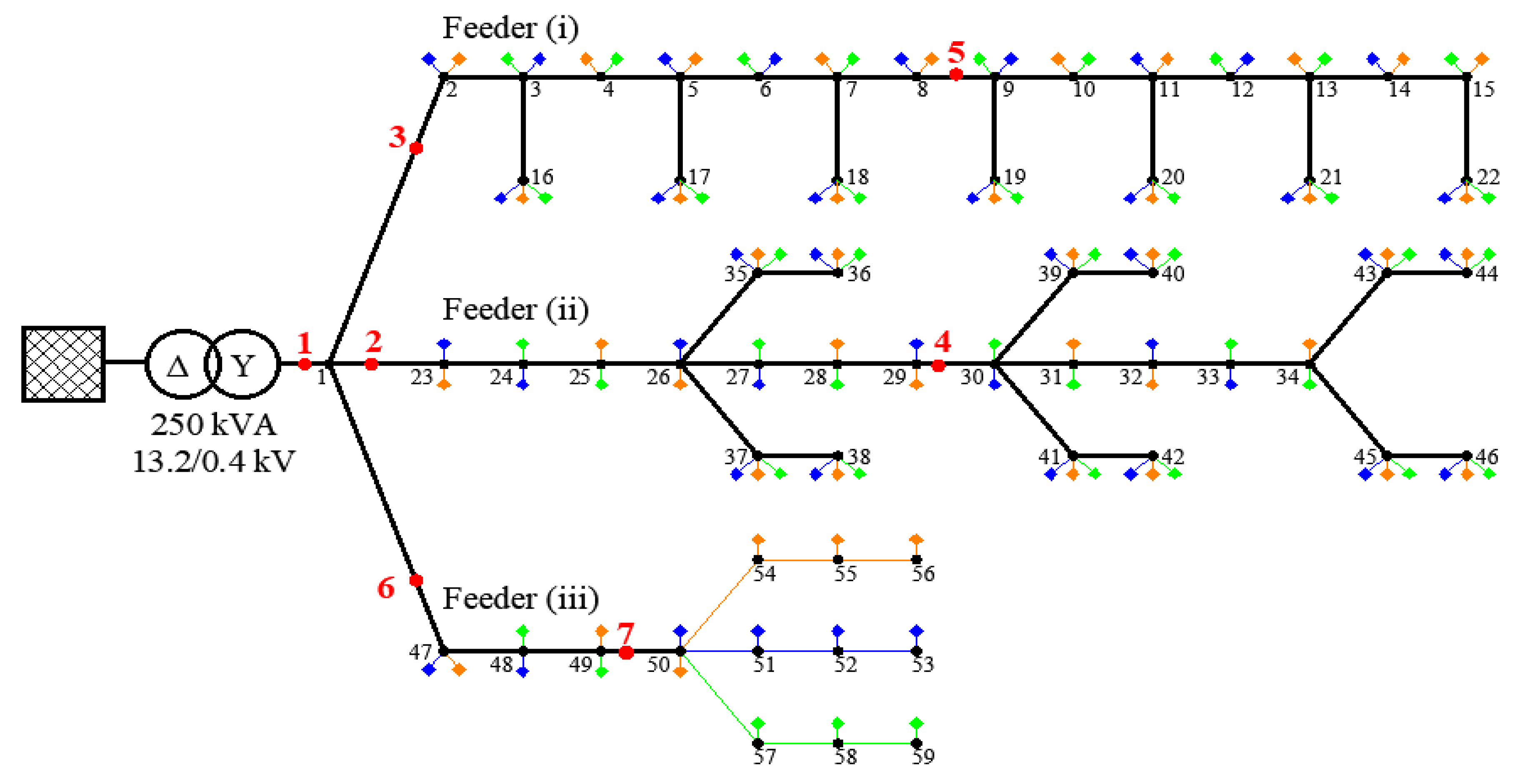
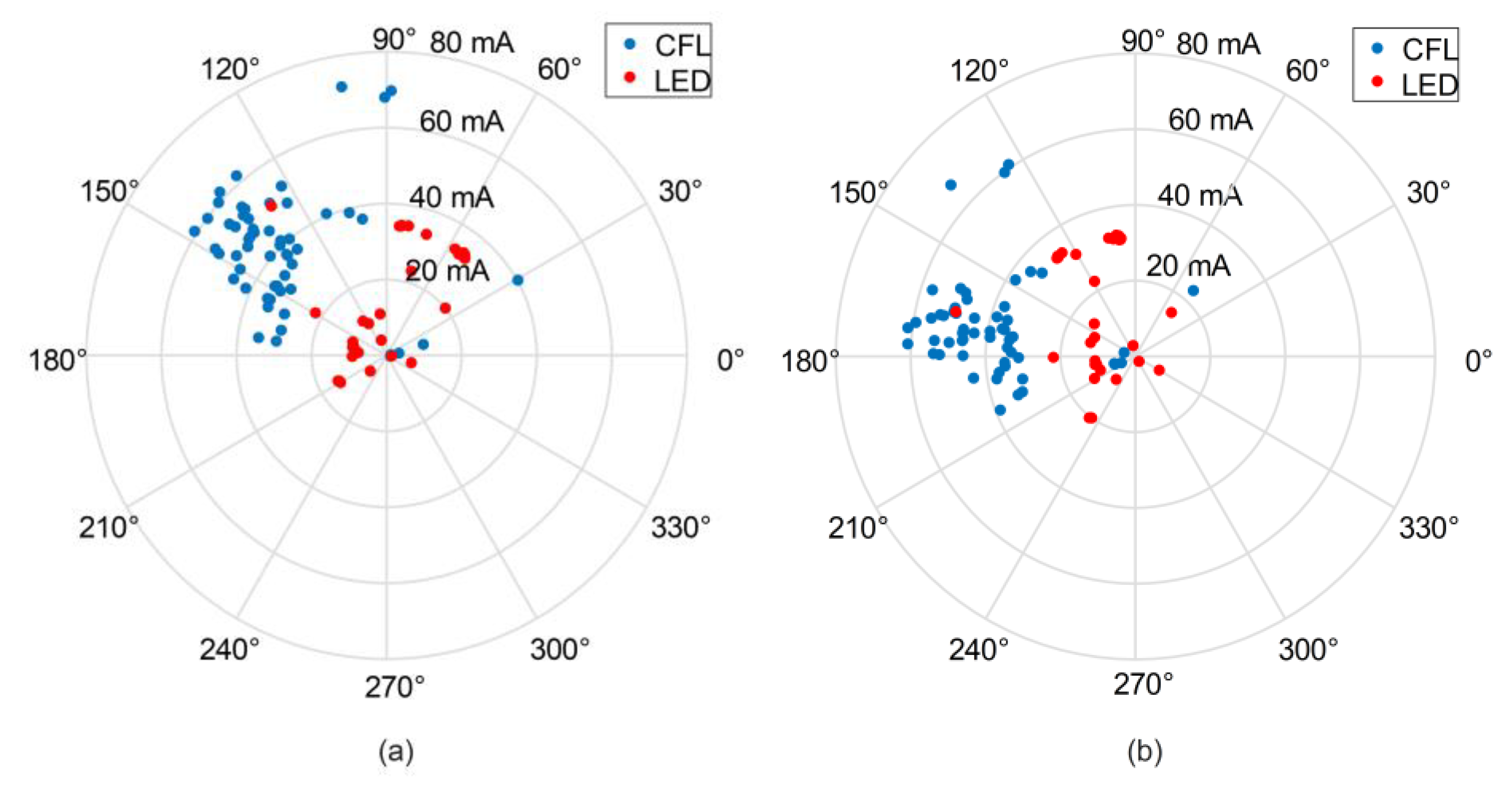


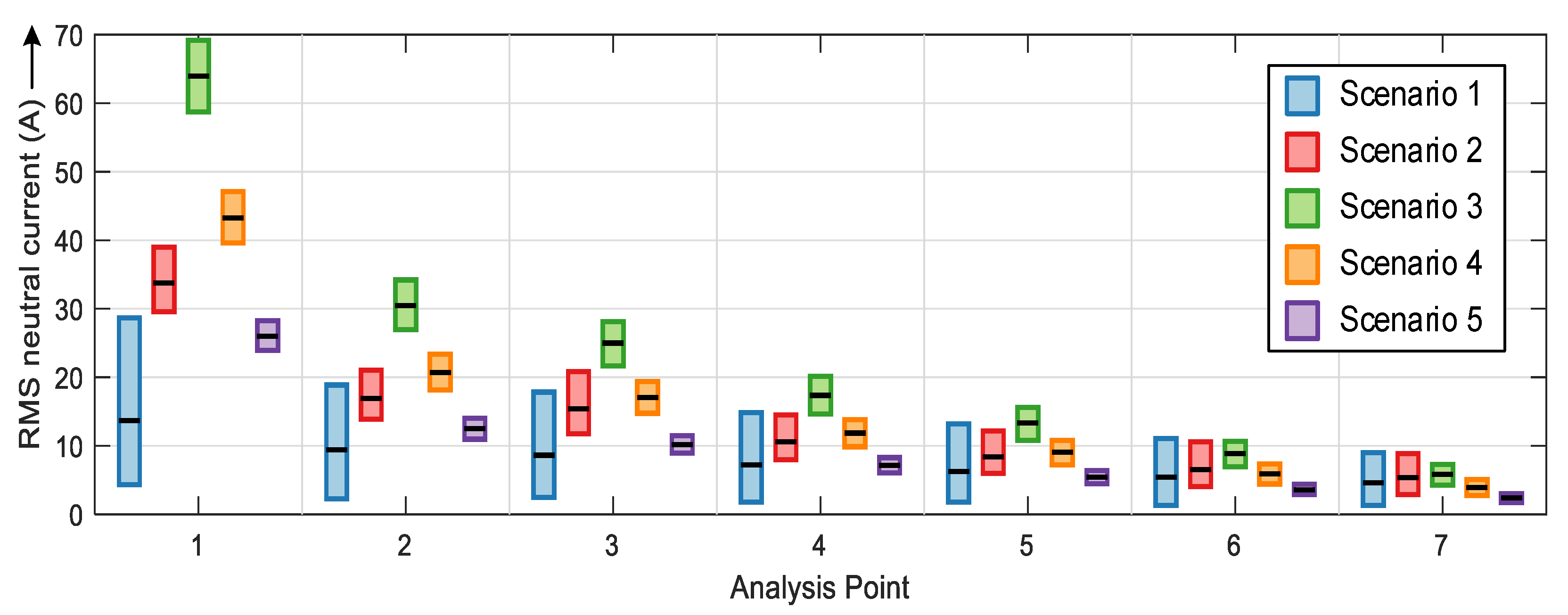
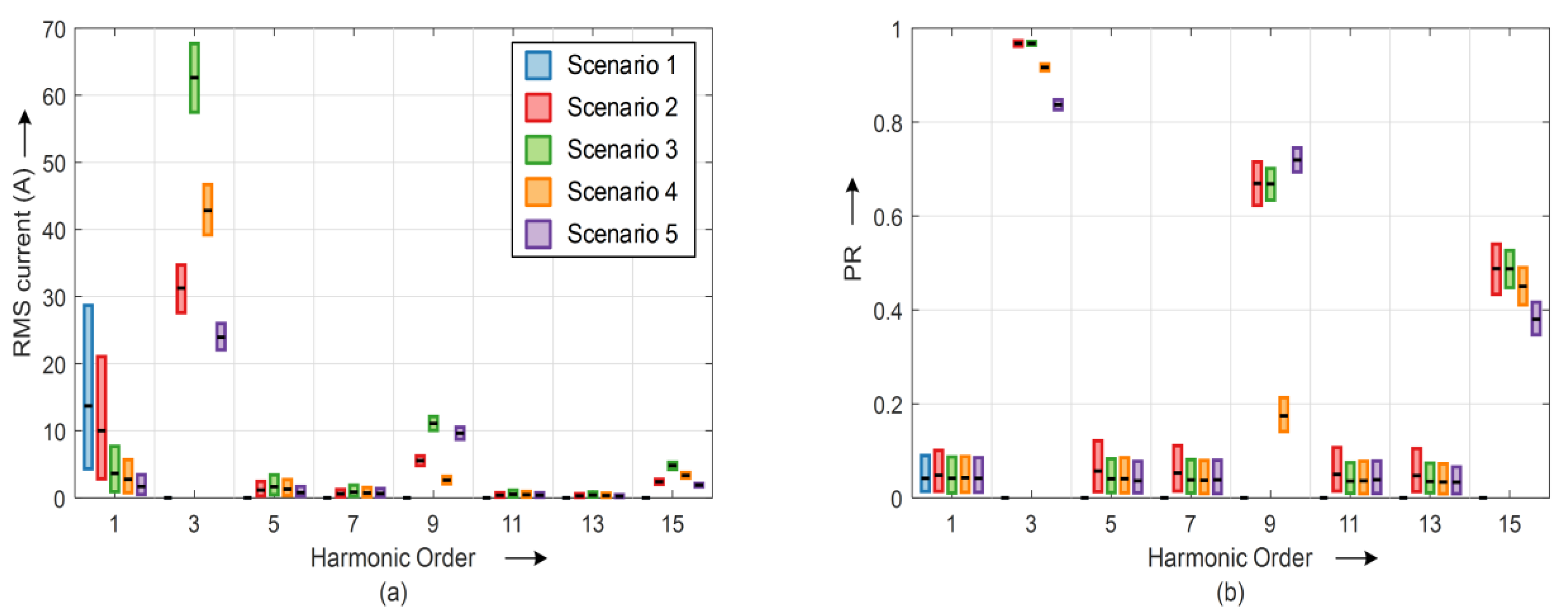
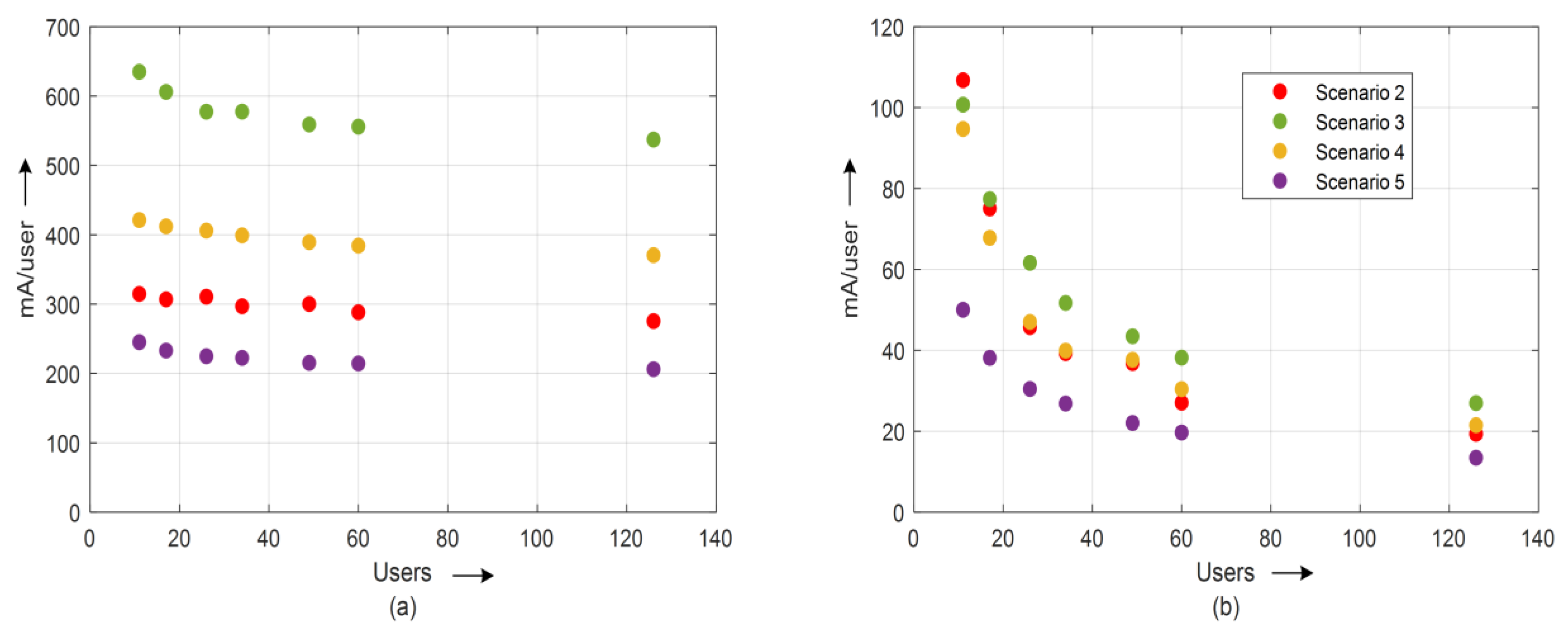
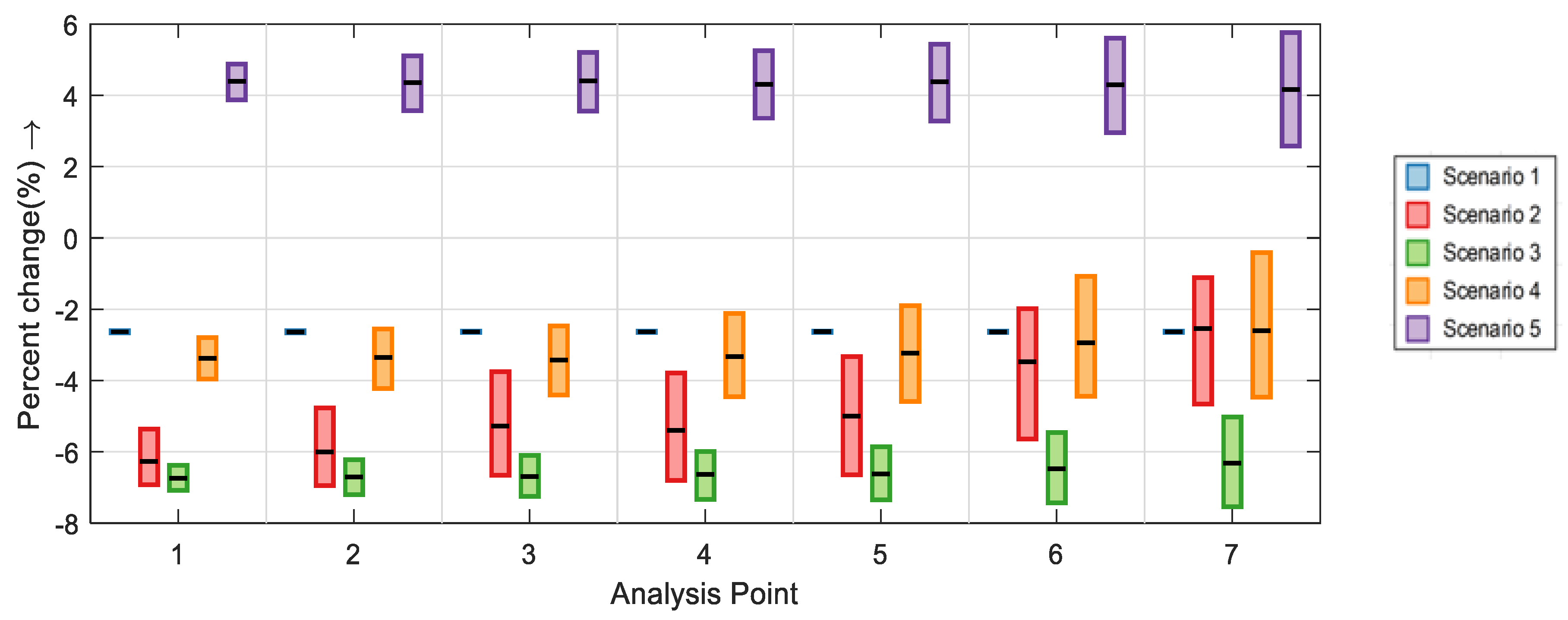
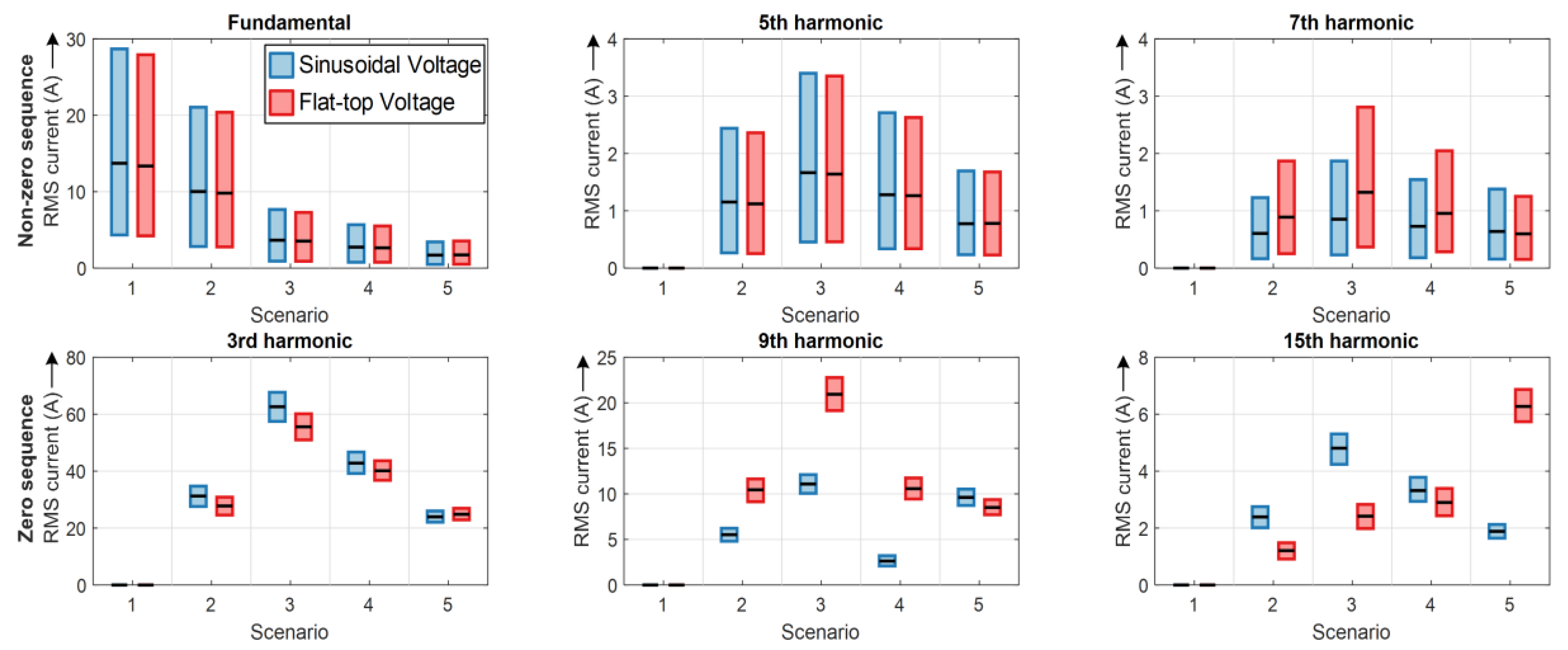
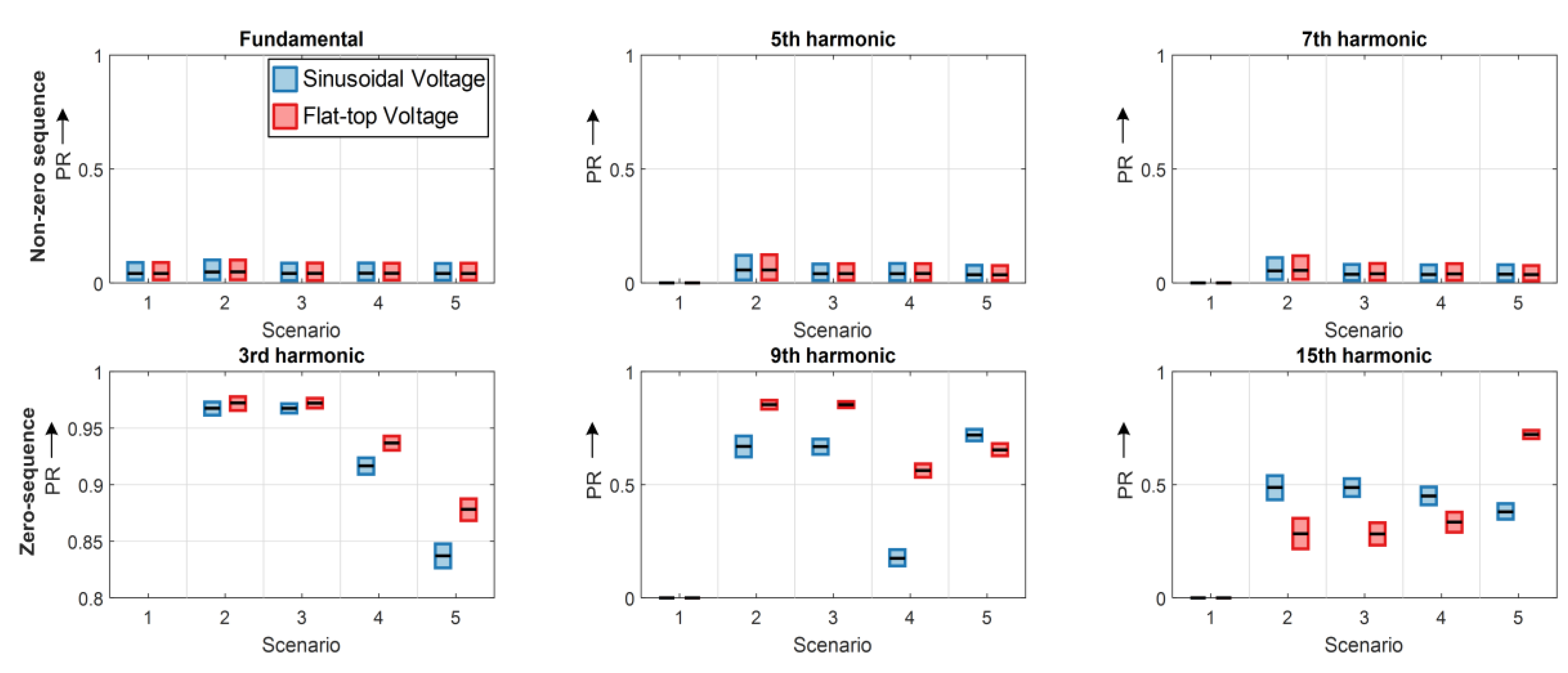
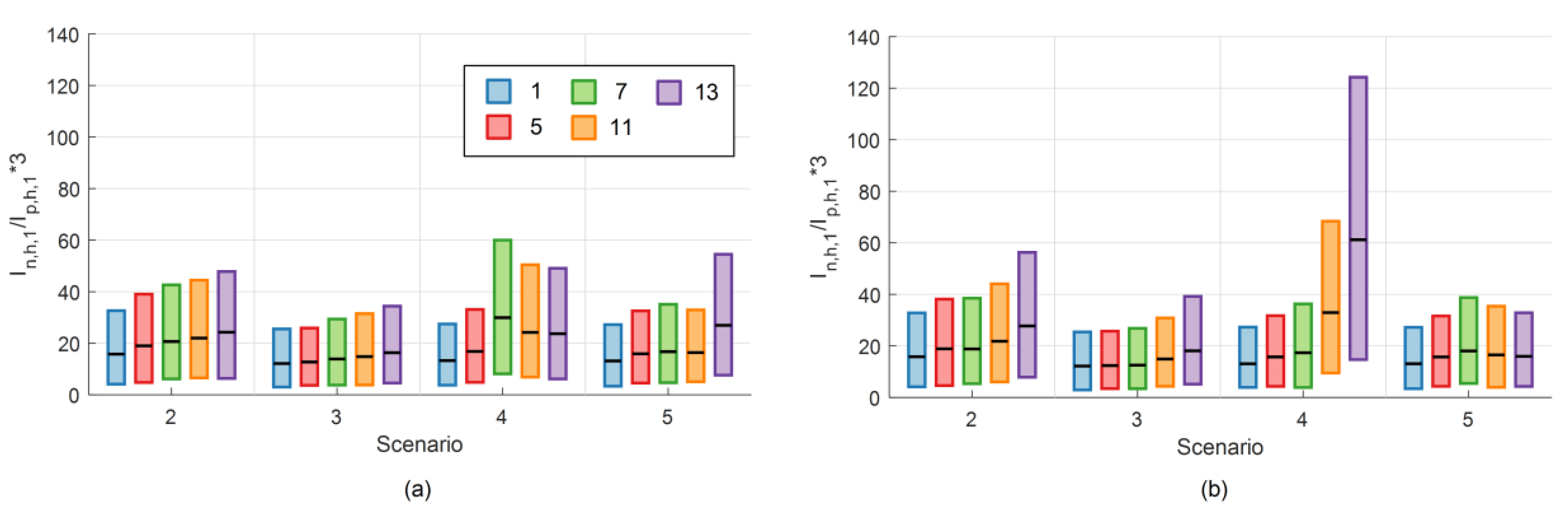


| Analysis Point. | 1 | 2 | 3 | 4 | 5 | 6 | 7 |
|---|---|---|---|---|---|---|---|
| Bus Number | 1 | 23 | 2 | 30 | 9 | 47 | 50 |
| Supplied Users | 126 | 60 | 49 | 34 | 26 | 17 | 11 |
| Rated Power (W) | Current (A), Sinusoidal Supply Voltage | Current (A), Flat-Top Supply Voltage |
|---|---|---|
| 60 | 0.261 | 0.254 |
| 75 | 0.326 | 0.318 |
| 100 | 0.435 | 0.423 |
| Scenario | IHL (%) | CFL (%) | LED (%) |
|---|---|---|---|
| 1 | 100 | 0 | 0 |
| 2 | 50 | 50 | 0 |
| 3 | 0 | 100 | 0 |
| 4 | 0 | 50 | 50 |
| 5 | 0 | 0 | 100 |
| Lamps in Operation | Weight per Lamp Number |
|---|---|
| 0–5 | 0.0476 |
| 6–10 | 0.0952 |
| 11–15 | 0.0476 |
| Range | PR ≥ 0.95 | 0.95 > PR ≥ 0.89 | 0.89 > PR ≥ 0.8 | PR < 0.8 |
|---|---|---|---|---|
| Level of cancellation | Very Low | Low | Medium | High |
| 3 | 5 | 7 | 9 | 11 | 13 | 15 | |
|---|---|---|---|---|---|---|---|
| Scenario 2 | 11.3% | 81.8% | 80.6% | 15.2% | 79.6% | 79.6% | 18.9% |
| Scenario 3 | 15.2% | 74.1% | 73.0% | 18.0% | 72.2% | 72.2% | 21.1% |
| Scenario 4 | 12.1% | 76.3% | 83.1% | 35.5% | 81.7% | 75.4% | 19.6% |
| Scenario 5 | 15.1% | 70.7% | 69.3% | 17.0% | 70.0% | 68.5% | 23.4% |
| Harmonic Order | ||||||||
|---|---|---|---|---|---|---|---|---|
| Scenario | 1 | 3 | 5 | 7 | 9 | 11 | 13 | 15 |
| 2 | 0.952 | −0.034 | 0.010 | 0.002 | −0.040 | −0.026 | −0.025 | −0.040 |
| 3 | 0.964 | −0.102 | 0.859 | 0.643 | −0.089 | 0.613 | 0.435 | −0.074 |
| 4 | 0.956 | −0.116 | 0.716 | 0.201 | −0.042 | 0.282 | 0.321 | −0.073 |
| 5 | 0.927 | −0.090 | 0.602 | 0.494 | −0.102 | 0.472 | 0.157 | −0.043 |

© 2020 by the authors. Licensee MDPI, Basel, Switzerland. This article is an open access article distributed under the terms and conditions of the Creative Commons Attribution (CC BY) license (http://creativecommons.org/licenses/by/4.0/).
Share and Cite
Hernández, J.; Romero, A.A.; Meyer, J.; Blanco, A.M. Impact of Nonlinear Lighting Loads on the Neutral Conductor Current of Low Voltage Residential Grids. Energies 2020, 13, 4851. https://doi.org/10.3390/en13184851
Hernández J, Romero AA, Meyer J, Blanco AM. Impact of Nonlinear Lighting Loads on the Neutral Conductor Current of Low Voltage Residential Grids. Energies. 2020; 13(18):4851. https://doi.org/10.3390/en13184851
Chicago/Turabian StyleHernández, Jairo, Andrés A. Romero, Jan Meyer, and Ana María Blanco. 2020. "Impact of Nonlinear Lighting Loads on the Neutral Conductor Current of Low Voltage Residential Grids" Energies 13, no. 18: 4851. https://doi.org/10.3390/en13184851
APA StyleHernández, J., Romero, A. A., Meyer, J., & Blanco, A. M. (2020). Impact of Nonlinear Lighting Loads on the Neutral Conductor Current of Low Voltage Residential Grids. Energies, 13(18), 4851. https://doi.org/10.3390/en13184851





